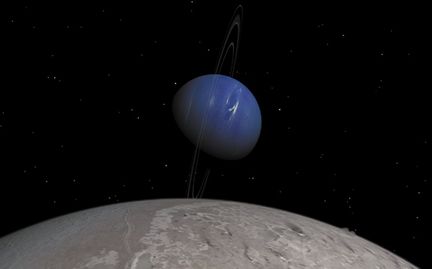
 |
|
This image shows what it would look like to be orbiting Neptune's moon Triton as Neptune itself comes into view. The dark rings are exaggerated to make them visible in this computer simulation using data from NASA's Voyager 2 mission. (From the Voyage scale model solar system, developed by Challenger Center for Space Science Education, the Smithsonian Institution, and NASA. Image created by ARC Science Simulations © 2001.) |
From Uranus, we must cross a distance equivalent to more than one and a half football fields to reach Neptune in our model. Neptune looks nearly like a twin of Uranus, with very similar size and composition, although it is more strikingly blue. Neptune has rings and at least eight moons. Its largest moon, Triton, is unusual both in having a "backward" orbit around Neptune (orbiting in a direction opposite to Neptune's rotation) and in having active sites that spew plumes of gas into the sky. The backward orbit leads astronomers to believe that Triton originally may not have been a moon but instead was captured by Neptune sometime after it formed.
Neptune's discovery was a triumph for the theory of gravity, developed by Isaac Newton in the late 1600s. By the mid-nineteenth century, careful observations of Uranus had shown its orbit to be slightly inconsistent with that predicted by Newton's theory of gravity. In the early 1840s, Englishman John Couch Adams suggested that the inconsistency could be explained by a previously unseen "eighth planet" orbiting the Sun beyond Uranus. By making calculations based on Newton's theory, he even predicted the location of the planet and urged a telescopic search. Unfortunately, Adams was a student at the time and was unable to convince British astronomers to carry out the search.
In the summer of 1846, French astronomer Urbain Leverrier made similar calculations independently. He sent a letter to Johann Galle, of the Berlin Observatory, suggesting a search for the eighth planet. On the night of September 23, 1846, Galle pointed his telescope to the position suggested by Leverrier. There, within 1° of its predicted position, he saw the planet Neptune. Hence, Neptune's discovery truly was made by mathematics and physics and was merely confirmed with a telescope.
 |
|
This map shows Neptune's location in the Voyage scale model solar system on the National Mall in Washington, DC. The image at the top of the page (next to title) shows Neptune's size on this scale. |